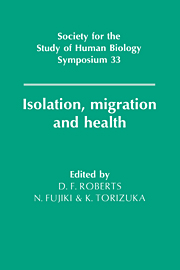Book contents
- Frontmatter
- Contents
- List of contributors
- Preface
- 1 The legacy of the IBP: Presidential Address
- 2 The distinction between primary and secondary isolates
- 3 Time trends in the break-up of isolates
- 4 Factors influencing the frequency of consanguineous marriages in Japan
- 5 Break-up of isolates
- 6 Isolates in India: their origin and characterisation
- 7 Consanguineous marriages and their genetical consequences in some Indian populations
- 8 Biomedical and immunogenetic variation in isolated populations in India
- 9 Genetic distance analyses in Israeli groups using classical markers and DNA polymorphisms in the β globin gene
- 10 Non-random distribution of Gm haplotypes in northern Siberia
- 11 Allele frequency estimation
- 12 Genetic affinities of human populations
- 13 Inherited neurological diseases in island isolates in southern Japan
- 14 Serological and virological evidence for human T-lymphotropic virus type I infection among the isolated Hagahai of Papua New Guinea
- 15 Analysis of genes associated with hypercholesterolaemia in the Japanese population
- 16 Migrant studies and their problems
- 17 Tokelau: migration and health in a small Polynesian society - a longitudinal study
- 18 Micromigrations of isolated Tuareg tribes of the Sahara Desert
- 19 Population structure in the eastern Adriatic: the influence of historical processes, migration patterns, isolation and ecological pressures, and their interaction
- 20 Diabetes and diabetic macroangiopathy in Japanese-Americans
- 21 Diabetes and westernisation in Japanese migrants
- 22 Environmental factors affecting ischemic heart disease
- Epilogue
- Index
17 - Tokelau: migration and health in a small Polynesian society - a longitudinal study
Published online by Cambridge University Press: 05 March 2012
- Frontmatter
- Contents
- List of contributors
- Preface
- 1 The legacy of the IBP: Presidential Address
- 2 The distinction between primary and secondary isolates
- 3 Time trends in the break-up of isolates
- 4 Factors influencing the frequency of consanguineous marriages in Japan
- 5 Break-up of isolates
- 6 Isolates in India: their origin and characterisation
- 7 Consanguineous marriages and their genetical consequences in some Indian populations
- 8 Biomedical and immunogenetic variation in isolated populations in India
- 9 Genetic distance analyses in Israeli groups using classical markers and DNA polymorphisms in the β globin gene
- 10 Non-random distribution of Gm haplotypes in northern Siberia
- 11 Allele frequency estimation
- 12 Genetic affinities of human populations
- 13 Inherited neurological diseases in island isolates in southern Japan
- 14 Serological and virological evidence for human T-lymphotropic virus type I infection among the isolated Hagahai of Papua New Guinea
- 15 Analysis of genes associated with hypercholesterolaemia in the Japanese population
- 16 Migrant studies and their problems
- 17 Tokelau: migration and health in a small Polynesian society - a longitudinal study
- 18 Micromigrations of isolated Tuareg tribes of the Sahara Desert
- 19 Population structure in the eastern Adriatic: the influence of historical processes, migration patterns, isolation and ecological pressures, and their interaction
- 20 Diabetes and diabetic macroangiopathy in Japanese-Americans
- 21 Diabetes and westernisation in Japanese migrants
- 22 Environmental factors affecting ischemic heart disease
- Epilogue
- Index
Summary
Introduction
The Tokelau Island Migrant Study was established in 1968 as a multidisciplinary study to test hypotheses relating to the process of change associated with migration, including factors influencing changing blood pressure patterns with age. In its broadest sense it is a study of the relationship between social change and health in this small Polynesian society (Prior et al., 1974). This has involved bringing together findings from three different scientific disciplines: ethnography, quantitative sociology, and epidemiology including genetic epidemiology. This report presents a brief review of the development of the project since it was commenced in 1968 together with a summary of some of the results of the cross-sectional and longitudinal analyses, particularly as regards body weight, diabetes, gout, hypertension and blood pressure. This synthesis outlines some of the dynamics and consequences of social change for individuals and populations. The study recognises that the migration process is complex and that it is taking place against the developing pattern of social change in two societies: Tokelau, the one from which the migrants originated, and New Zealand, the host country in which most of the migrants settled.
Tokelau is very small and, in geopolitical terms, isolated and insignificant. The three small atolls of Tokelau (Fakaofo, Nukunonu and Atafu) lie 480km north of Samoa and 3,200km from New Zealand (Figure 17.1). In 1966 there were 1901 Tokelauans in Tokelau and 445 in New Zealand. A hurricane in Tokelau led to the establishment of the Tokelau Resettlement
Programme by the New Zealand Government bringing Tokelauans to New Zealand.
- Type
- Chapter
- Information
- Isolation, Migration and Health , pp. 171 - 191Publisher: Cambridge University PressPrint publication year: 1992



